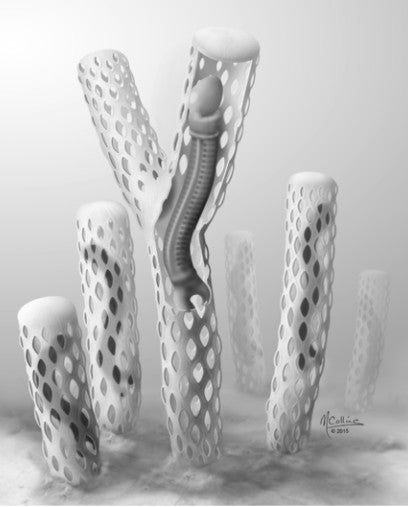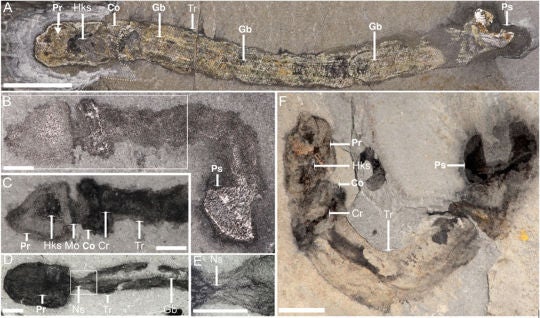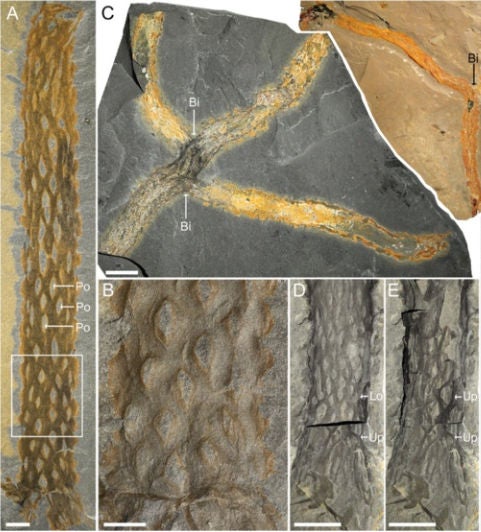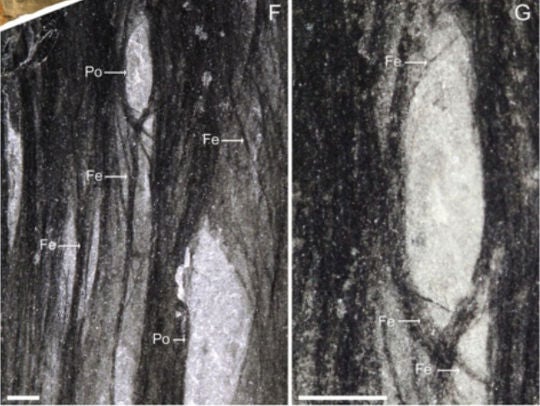This article was published in Scientific American’s former blog network and reflects the views of the author, not necessarily those of Scientific American

Long before sharks, there was the shark cage. Newly discovered fossils indicate the defense devices were invented 500 million years ago by an enterprising marine worm whose fortifications are so unusual they have long been mistaken for a seaweed. Eat your heart out, Discovery Channel.
At least, that is the conclusion of a new study published in July in the journal BMC Biology of fossils from a stunning new locality of the Burgess Shale called Marble Canyon in Canada’s Kootenay National Park. After discovering, among hundreds of new specimens, dozens of fossils showing the worm in question hanging out inside the alleged seaweed, scientists from Canada and the United Kingdom -- including famed Burgess Shale expert Simon Conway Morris -- decided to re-evaluate the prevailing wisdom.
On supporting science journalism
If you're enjoying this article, consider supporting our award-winning journalism by subscribing. By purchasing a subscription you are helping to ensure the future of impactful stories about the discoveries and ideas shaping our world today.

Fossils showing worms inside the "alga" Margaretia. Wo=worm, Ps=posterior structure, Pr= proboscis, co=collar, tr=trunk. Credit: Nanglu et al. 2016
If the seaweed is indeed a worm cage, it means the worm jumps from being a rare member of this extremely ancient animal community to one of the most common. That’s because the fossils of its tube, formerly considered to be the alga Margaretia, are found all over the world, while the worms’ fossils are found only in Canada. Further, the fossils may be helpful to understanding our own evolution because based on these new specimens, scientists have newly identified the worm as a close relation to vertebrates with many living descendants. We talked about them here recently: acorn worms.
As I wrote in October, modern acorn worms posses a distinctive anatomy of proboscis, collar, and trunk. The appearance of the proboscis sitting inside the collar is what gives them their name.

The acorn worm Oesia. Pr= proboscis, co=collar, tr=trunk, Gb= gill bars, Ps=posterior structure. Credit: Nanglu et al. 2016
Unlike modern acorn worms, however, the fossil worm sometimes seems to have had a bulbous, forked rear end that it may have used to grasp and maneuver around its cage. Additionally, Oesia, as the worm is called, seems to have had many more of the gill bars modern worms use to breathe, perhaps because the worm was also using them to filter food from the water.
The cage-dwelling worms – fittingly, perhaps -- seem to have preferred the single life. In worm+cage fossils, only one worm has been found per dwelling. However, since many fossils are broken, it’s possible that they sometimes had roommates. It does seem to have been a roomy cage: the tube was usually twice the width of the worm, yielding a capacious living space with plenty of room to move. The tubes occasionally branched.

Oesia tube structures. Po=pore, Bi=bifurcation. D-E a chunk of fossil has broken off in D and is replaced in E to show the inner and outer surface of the tube. Lo=lower surface of tube, Up=upper surface of tube. Credit: Nanglu et al. 2016
In the walls of the tube was a spirally arranged series of pores with raised edges, about 10 per revolution. Some were nearly blocked, but others could be as wide as one-third the tube width. Some fossil tubes with irregular shapes whose pores do not spiral have been found, and these may have been anchors that extended horizontally under the seabed. The top end of the tube seems to have been closed, providing complete home security, but necessarily restricting social engagements.
The tube itself seems to have been made of tiny fibers either braided or bundled together.

Close up of the fibers that form Oesia tubes. Po=pores, Fe=fibrous elements. Credit: Nanglu et al. 2016
The combination of a fibrous superstructure and a pore manifold makes the tube unlike the structure of any known algae of the era. Thus, the authors conclude that it is less likely that the worm was simply living inside a seaweed than a worm building a structure that bears a vague resemblance to one.
Since the pores perforate the entire tube, the scientists suggest they stood upright. Given that the largest was more than 20 inches (50 cm) long, if this is correct they would have rivaled the tallest known Burgess Shale sponges. Lofty, perforated cages combined with extensive gills seems to indicate these worms were filter feeders that sifted food particles from water much the same way whales use baleen, using their cages as a safe perch in which to access faster moving (and thus more food-rich) water further from the sea floor. The pores would have allowed food and oxygen to enter and waste products to exit, while the cage would have deterred predators.
However, many Oesia worms were found without tubes and many tubes without worms. Why? One possibility is that they’re in those tubes, we just can’t see them. The worms may still be inside, but hidden unless the fossil is split open or the tube cage partially decayed prior to burial.
There are some other scenarios, however. It’s possible worms could live with or without cages. Or perhaps there was a mass evacuation following some sort of traumatic event, although the lack of any obvious escape hatch makes this less likely, the authors concede. Most likely, the tubes simply broke and the worms floated away prior to fossilization.
Previously, Oesia had only been found at the classic Walcott Quarry Burgess Shale site – famously discovered by Charles Doolittle Walcott in 1909 -- and it was rare there. At Marble Canyon, though, Oesia is abundant. The former Margaretia is found in Burgess shale sites around the world: British Columbia; Utah: southern China; and Siberia. This suggests acorn worms were an important member of the Cambrian community.
Today, most acorn worms feed in and on sediment rather than filtering water, but these fossils suggest that sediment feeding came later and supports the idea that filter feeding was the ancestral condition of all deuterostomes, a vast group of animals that includes the vertebrates, the echinoderms (starfish, etc.) and the acorn worms and their relatives. Why did they switch? Perhaps as predators grew larger and more heavily armed, Oesia found their convenient, attractive, and spacious – but breakable -- filter-feeding high rises were no longer sufficient to the job of compound security, and they gradually abandoned them for the comparative safety of the seabed.
Reference
Nanglu, Karma, Jean-Bernard Caron, Simon Conway Morris, and Christopher B. Cameron. "Cambrian suspension-feeding tubicolous hemichordates." BMC Biology 14, no. 1 (2016): 56.